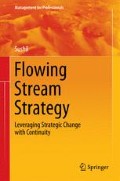Abstract
The proposed process categorizes continuity and change forces that are acting on an organization and shortlists the vital and desirable ones out of them. On the basis of the continuity–change combinations, it might use any one or all of the four strategic channels (divert, shift, partition, and integrate) to select suitable strategies at various levels of strategic flexibility. An organization can use these strategic channels with growing strategic maturity in the flow; at the highest level of maturity, the organization might implement all the four channels. The most widely used strategic channel is divert, followed by shift, and then partition; the channel integrate is used sparingly and needs richer strategic insight.
Access this chapter
Tax calculation will be finalised at checkout
Purchases are for personal use only
Notes
- 1.
Part of the chapter is based on Sushil (2012b).
References
Bhat, J. S. A., Sushil, & Jain, P. K. (2011). Innovation by harmonizing continuity and change. Journal of Business Strategy, 32(2), 38–49.
Gupta, V. K. (2010). Flexible strategic framework for managing forces of continuity and change: Study of supply chain management of lighting industry in India. Global Journal of Flexible Systems Management, 11(3), 39–50.
Nasim, S. (2011). Total interpretive structural modeling of continuity and change forces in E-government. Journal of Enterprise Transformation, 1(2), 147–168.
Sushil. (2001). SAP-LAP framework. Global Journal of Flexible Systems Management, 2(1), 51–59.
Sushil. (2010). Flexible strategy game-card. Global Journal of Flexible Systems Management, 11(1 & 2), iii–iv.
Sushil. (2012a). Flowing stream strategy: Managing confluence of continuity and change. Journal of Enterprise Transformation, 2(1), 26–49.
Sushil. (2012b). Making flowing stream strategy work. Global Journal of Flexible Systems Management, 13(1).
Sushil, Garg, R. K., & Jain, S. (2010). Status of continuity forces in Indian industry: A survey. International Journal of Business Continuity and Risk Management, 1(2), 166–186.
Author information
Authors and Affiliations
Rights and permissions
Copyright information
© 2013 Springer India Pvt. Ltd.
About this chapter
Cite this chapter
Sushil (2013). Flowing Stream Strategy Process. In: Flowing Stream Strategy. Management for Professionals. Springer, New Delhi. https://doi.org/10.1007/978-81-322-0726-9_11
Download citation
DOI: https://doi.org/10.1007/978-81-322-0726-9_11
Published:
Publisher Name: Springer, New Delhi
Print ISBN: 978-81-322-0725-2
Online ISBN: 978-81-322-0726-9
eBook Packages: Business and EconomicsBusiness and Management (R0)

